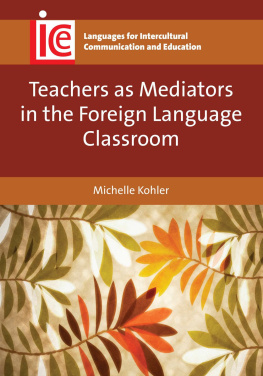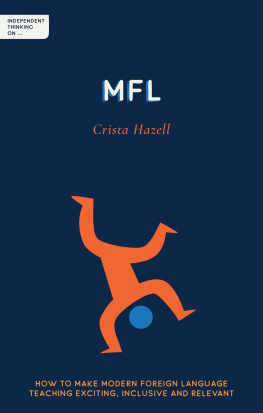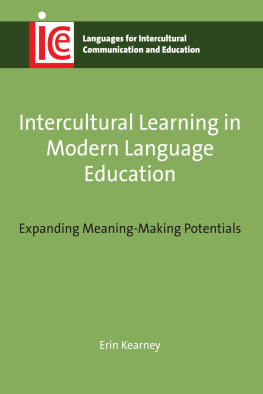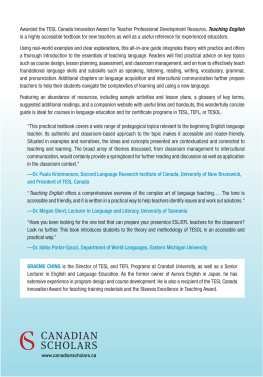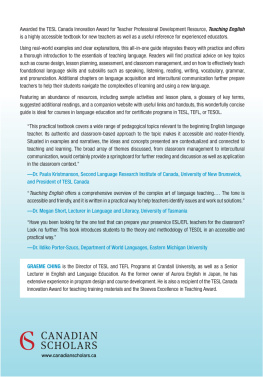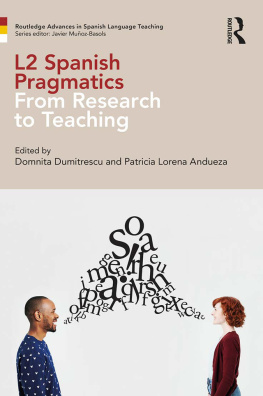Teachers as Mediators in the Foreign Language Classroom
LANGUAGES FOR INTERCULTURAL COMMUNICATION AND EDUCATION
Series Editors: Michael Byram, University of Durham, UK and Alison Phipps, University of Glasgow, UK
The overall aim of this series is to publish books which will ultimately inform learning and teaching, but whose primary focus is on the analysis of intercultural relationships, whether in textual form or in peoples experience. There will also be books which deal directly with pedagogy, with the relationships between language learning and cultural learning, between processes inside the classroom and beyond. They will all have in common a concern with the relationship between language and culture, and the development of intercultural communicative competence.
Full details of all the books in this series and of all our other publications can be found on http://www.multilingual-matters.com, or by writing to Multilingual Matters, St Nicholas House, 31-34 High Street, Bristol BS1 2AW, UK.
Library of Congress Cataloging in Publication Data
A catalog record for this book is available from the Library of Congress.
Kohler, Michelle - author.
Teachers as Mediators in the Foreign Language Classroom/Michelle Kohler.
Languages for Intercultural Communication and Education: 27
Includes bibliographical references and index.
1. Language and languagesStudy and teachers. 2. Interlanguage (Language learning) 3. Intercultural communicationStudy and teaching. 4. Language teachers. 5. Mentoring. I. Title.
P53.K596 2015
407.1dc23 2014033092
British Library Cataloguing in Publication Data
A catalogue entry for this book is available from the British Library.
ISBN-13: 978-1-78309-306-9 (hbk)
ISBN-13: 978-1-78309-305-2 (pbk)
Multilingual Matters
UK: St Nicholas House, 31-34 High Street, Bristol BS1 2AW, UK.
USA: UTP, 2250 Military Road, Tonawanda, NY 14150, USA.
Canada: UTP, 5201 Dufferin Street, North York, Ontario M3H 5T8, Canada.
Website: www.multilingual-matters.com
Twitter: Multi_Ling_Mat
Facebook: https://www.facebook.com/multilingualmatters
Blog: www.channelviewpublications.wordpress.com
Copyright 2015 Michelle Kohler.
All rights reserved. No part of this work may be reproduced in any form or by any means without permission in writing from the publisher.
The policy of Multilingual Matters/Channel View Publications is to use papers that are natural, renewable and recyclable products, made from wood grown in sustainable forests. In the manufacturing process of our books, and to further support our policy, preference is given to printers that have FSC and PEFC Chain of Custody certification. The FSC and/or PEFC logos will appear on those books where full certification has been granted to the printer concerned.
Typeset by Deanta Global Publishing Services Limited.
Printed and bound in Great Britain by the CPI Group (UK Ltd), Croydon, CR0 4YY.
Contents
For some decades there has been an increasing recognition and understanding of the place of culture in language education as a basis for more effective language learning and understanding of other world views. The global reality of superdiversity (Vertovec, 2010) and increasing multilingualism (Bloomaert et al ., 2012) has further focused attention on the importance of developing capabilities to engage with other languages and cultures in meaningful and mutually beneficial ways. The shift towards an intercultural orientation in language teaching and learning is viewed as a means of achieving these capabilities.
There is now a substantive body of work related to intercultural language teaching and learning which is largely theoretical in orientation, focusing on conceptual frameworks and considerations for practice. There is less work related to investigating practice and in particular how intercultural language teaching and learning occur in the foreign language classroom. There is little work in particular on mediation and the role of language teachers as mediators of intercultural language learning. This book focuses on precisely this area of practice. It examines in detail how teachers of languages mediate intercultural language learning with their students in the daily reality of school language programmes. It is an account of language teachers and their students who live the experience of intercultural language teaching and learning, and of the research process through which this account was reached. The main body of the book presents the findings of the research; however, the reader who is interested in the process will find in this introduction and in the detailed appendices an explanation of the participant action research that was undertaken.
This book presents a multiple case study of three foreign language teachers in Australian schools who participated in an investigation that I conducted into how teachers of languages mediate intercultural language learning in their teaching practice. The study evolved in response to my own interest and awareness of both an increasing critique in the field of applied linguistics and language education of communicative language teaching, and a shift towards intercultural language teaching and learning. This shift paralleled my own experience as a former secondary school language teacher with students who were not willing to undertake pseudo communication tasks and who were demanding greater relevance, conceptually demanding and meaningful language learning experiences.
At the time, communicative language teaching heralded a new era of language teaching in which the social and purposeful nature of language was foregrounded. It did, however, become realised in ways that were not beneficial and one of the major criticisms has been that communicative language teaching has largely focused on an idealised monolingual, native speaker norm (Byrnes, 2006). It has assumed that both language learners and users have discrete languages and that the goal in teaching and learning is to acquire a further discrete language (the target language) in order to communicate fluently with native speakers of that language. Others criticisms include that communication in this approach has become primarily transactional in orientation, that it is biased towards listening and speaking, and often results in formulaic or rehearsed language that is detached from its real-world contexts and purposes of use (Eisenchlas, 2010; Legutke & Thomas, 1991; Leung, 2005; Scarino & Liddicoat, 2009).
The criticisms of communicative language teaching, together with emerging understandings of language and culture, have resulted in efforts over recent decades to generate new theoretical frames that recognise the significance of culture and context in language use (Byram, 1991; Damen, 1987; Kramsch, 1993, 1995). Sociocultural competence (Nostrand, 1991) and intercultural competence (Buttjes, 1991; Byram, 1988) were new models that attempted to do just that. Indeed, Byram and Alred (2002) suggested that the notion of an intercultural speaker was a more appropriate goal for language teaching and learning, reflecting the difference between the processes of first language acquisition and ones primary socialisation, and that of additional language learning and tertiary socialisation. Others have proposed a goal that is oriented towards functional multilingualism and the capability of language learners to navigate and move between multiple languages and cultures; being an intercultural meaning maker (Byrnes, 2006; Kramsch, 2006b; Risager, 2007).
Much of the initial work related to intercultural competence was theoretical in nature, attempting to conceptualise the area and identify considerations for research and practice (Buttjes, 1991; Byram, 1989, 1991; Byram et al ., 1994; Byram & Zarate, 1994; Crozet & Liddicoat, 2000; Damen, 1987; Kramsch, 1993, 1995, 1998, 2008; Lo Bianco, 2003; Paige et al ., 1999). Following this, work has become more practice oriented, addressing various dimensions. For example, studies have focused on evaluating textbooks in terms of their representations of language and culture in materials for language teaching (Kramsch, 1987; Sercu, 2000). In the area of curriculum, Byram et al . (2001) investigated teachers planning and programming practices using learning objectives in a number of different countries and contexts. Liddicoat et al . (2003) developed a set of principles and outlined their related implications for curriculum, assessment, teaching and learning. Sercu (2005) has investigated language teachers perceptions of the cultural dimension of their work, finding that while they were willing to support cultural objectives in language teaching, they remained committed to a communicative orientation in practice. Sercu (2006) also found that despite expectations that language teachers were incorporating an intercultural orientation in their teaching, a significant number of them reported difficulties and remain focused on traditional pedagogies. More recently, Liddicoat and Scarino (2013) exemplify aspects of intercultural language teaching with vignettes of teachers practice drawn from a number of research studies and professional learning programmes. In the higher education context, Diaz (2013) reports on curriculum design and implementation in Italian and Chinese programmes, highlighting various stumbling blocks to implementing an intercultural orientation in practice, and proposing a framework to address what she regards as a theory and practice divide.

